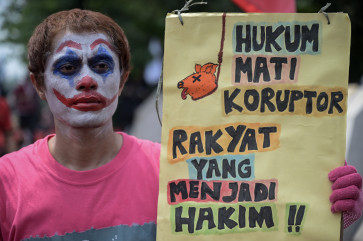Popular Reads
Top Results
Can't find what you're looking for?
View all search resultsPopular Reads
Top Results
Can't find what you're looking for?
View all search resultsThe Garuda soars to grandeur
Hundreds of performers suddenly appeared at the top of the 20-meter-high stairway, and the audience on the ground gasped in awe
Change text size
Gift Premium Articles
to Anyone
H
undreds of performers suddenly appeared at the top of the 20-meter-high stairway, and the audience on the ground gasped in awe.
The performers carried burning bamboo torches that formed wild, terrifying glimmers on the gigantic copper statue of the Garuda head in the background. It was a visual spell that instantly mesmerized the spectators.
The performers then in unison chanted the primitive screams, 'cak, cak', drawn from the chorus of the Sanghyang sacred dance, as they descended the steps of the stair. The burning torches were held high in the air as the massive column of bare-breasted performers swayed from side to side on its march to the ground.
The column soon evoked the image of a furious fire-breathing dragon ready to devour everything that stood in its way. Smoke from the torches hovered over the stage, adding a sense of other-worldliness to this scene from a show about two mythological creatures: Naga, the dragon, and Garuda, the invincible king of birds.
Performed late last August during the ground-breaking ceremony for the Garuda Wisnu Kencana (GWK) ' a 126-meter-tall monument designed to be the island's new cultural icon ' the show, The Garuda Repertoire, was the brainchild of Putu Fajar Arcana, senior journalist for Kompas and prominent Bali-born author, whose novels and poems often draw inspiration from the lore and mythology of his home island.
Garuda Repertoire was no exception. Arcana picked a story that was very popular among the island's lovers of wayang kulit shadow puppet shows and traditional paintings and developed it into a captivating modern performance.
Garuda is one of the protagonists portrayed in Adi Parwa, the first volume of the 18-volume epic Mahabharata. It is said that he is a mighty creature whose power terrifies even the gods. When he was born, his body emanated a fiery light that almost consumed the universe.
Garuda has only one mission in life: liberating his mother Winata from enslavement. She lost a rigged bet to his rival Kadru and paid the price of having to become a servant for Kadru's offspring of 100 dragons. The dragons tell Garuda that he can have his mother back once he delivers Amerta, the elixir of immortality, to them.
The winged hero agrees and immediately storms the gates of heaven, where the elixir is tightly guarded by the gods and their magical weapons. None can stop Garuda. A famous painting from Kamasan captures this moment beautifully: various magical weapons ' from serpentine arrows to flaming clubs ' break or bend before they even touch Garuda's skin. The battle ends when Lord Wisnu the Sustainer bestows the elixir to Garuda on one condition: he must ensure that the dragons will never drink the elixir.
The story has a happy ending. Garuda liberates his mother, and the dragons only manage to lick a minuscule amount of the Amerta, thus, securing them longevity but not immortality. Garuda becomes the eternal guardian of the elixir, and the trusted mount of Wisnu.
Arcana depicted the ancient story in a refreshingly new way. He recruited the famed Kecak Rina troupe to form the main dramatic structure of the performance. Hundreds of the troupe's kecak dancers at different points assumed the primary role of the dragons and the minor roles, including stones, winds and the sky. I Ketut Rina led his dancers with
an energy and intensity that amazed the audience.
The troupe also provided the main musical element of the performance. Through their vocal chorus, constituted mostly of the word 'cak' in varying degrees of volume and urgency, the dancers dictated the pace and rhythm of the performance.
Guitar prodigy Dewa Budjana, famed singers Trie Utami and Agung Ocha, and harpist Maya Hasan added contemplative mood music to the performance. Arcana did not place them in a supporting role tasked with producing a musical illustration to the unfolding story. Instead, each presentation was a defining scene in the plot, a single musical interpretation of the story.
The intensity of the kecak dancers was interwoven with and punctuated by the adoration of Budjana's heart-melting melodies, the sublime yearning for motherly love from Maya Hasan's delicate touches on the harp and the spiritual submission of Utami's and Ocha's hypnotic songs.
Coupled with a brilliant performance presented by Keni Kurniasari, the beloved pupil of Bulantrisna Djelantik ' the grand dame of Bali's Legong dance ' the performance successfully dodged the trap of superficiality that often mars a union between traditional and modern elements.
Dressed in a glittering, silver Legong wardrobe, Keni was the star of the performance. She jumped, glided, soared as a very convincing Garuda. Her performance was beautiful, tough, subtle and dominating. Most of her gestures and movements were obviously inspired by those of the classical Legong Keraton. But the energy and character immersion were definitely her own.
When the performance reached its end ' right after Keni appeared on a mobile platform to declare Garuda's victory over the dragons and the sky erupted with dazzling fireworks ' Utami captured the spirit of the whole evening through a touching rendition of Padamu Negeri (To My Country), and the spectators answered with a standing ovation.
The Garuda Repertoire was a lavish, colossal and dramatic performance. But, deep inside, it was a simple play with simple messages: that love is always worth fighting for and that freedom is never a gift ' it is something that must be earned and preserved. It was a good thing that Arcana managed to convey those messages amid the overwhelming visual elements of the show.










